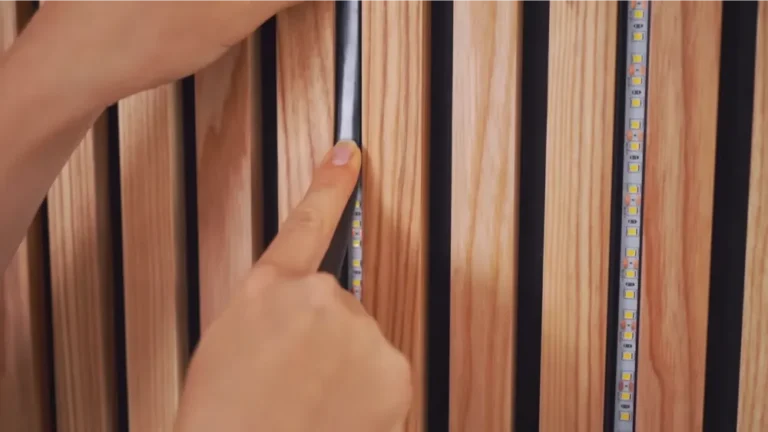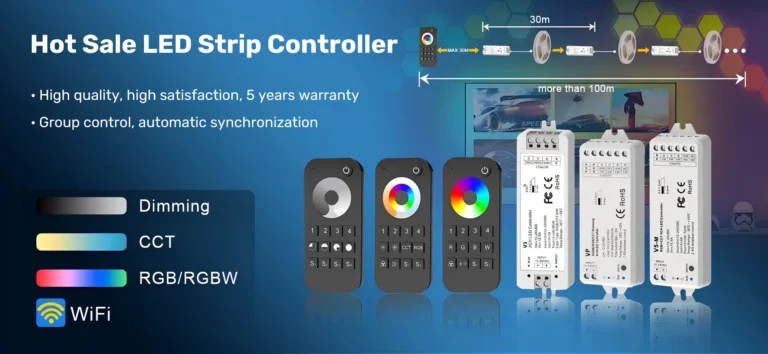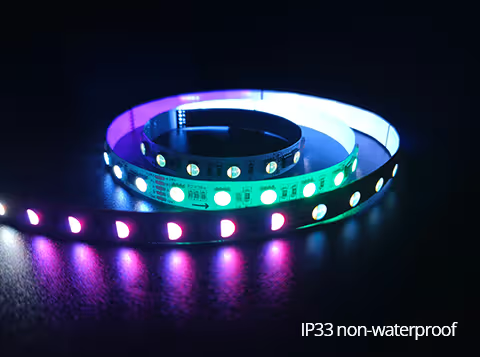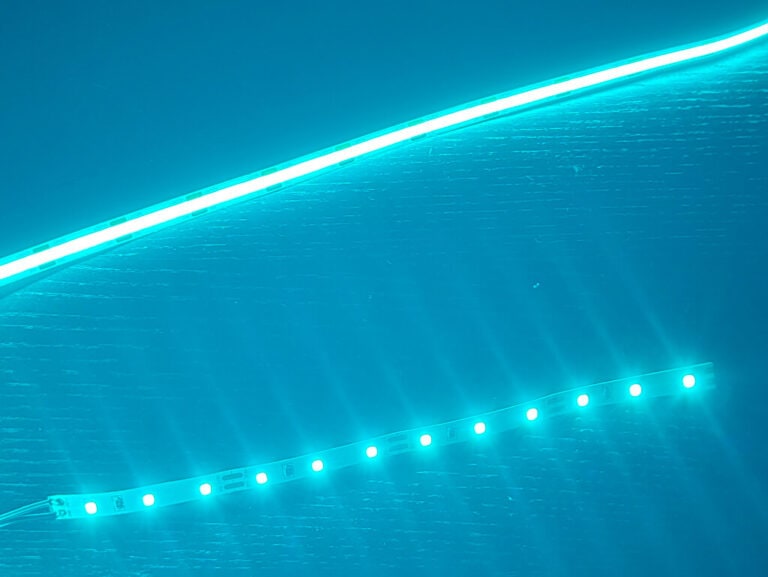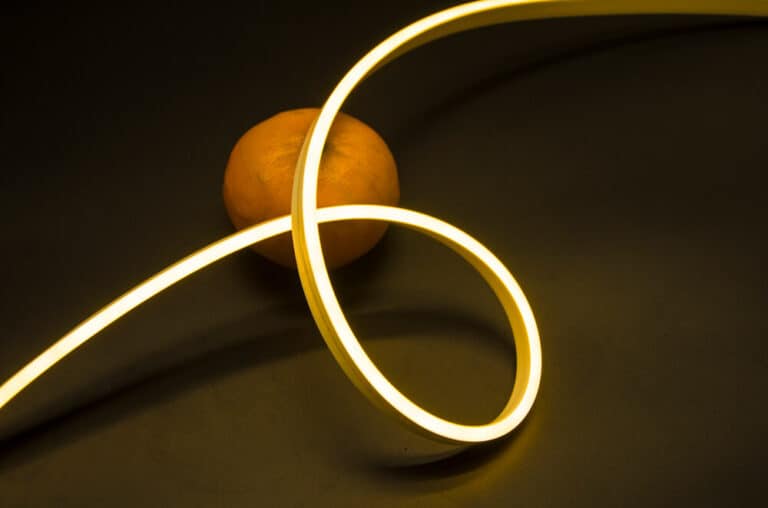Quando si pianifica un progetto di illuminazione a LED, per vetrine, facciate di edifici, illuminazione per ufficio o segnaletica, la comprensione del consumo energetico delle luci a LED è un passaggio fondamentale. Non solo ti aiuta a selezionare l'alimentatore appropriato per evitare il sovraccarico del circuito, ma influisce anche sul budget energetico complessivo del progetto e sui costi operativi a lungo termine.
Luci a striscia LED, con le loro caratteristiche efficienti dal punto di vista energetico, hanno gradualmente sostituito i metodi di illuminazione tradizionali. Tuttavia, nell'uso effettivo, il loro consumo energetico è influenzato da molteplici fattori, come la potenza per metro (W/m), la tensione di ingresso (ad es. 12V/24V), la densità dei LED (numero di LED) e la durata dell'uso quotidiano. Per i progetti di illuminazione commerciale e industriale, anche una differenza di pochi watt al metro può comportare differenze significative nel costo dell'elettricità a lungo termine.
In questa guida completa, forniremo un'analisi dettagliata di:
- Come calcolare il consumo energetico e i costi dell'elettricità delle strisce luminose a LED (Watt e kWh)
- Fattori che influenzano il consumo energetico effettivo delle strisce luminose
- Confronto delle differenze di consumo energetico tra i tipi comuni di strisce luminose a LED
- Come selezionare strisce luminose a LED ad alta efficienza energetica
- Casi di studio del mondo reale e raccomandazioni per il risparmio energetico per migliorare l'efficacia in termini di costi del progetto
Successivamente, inizieremo con le basi: come viene calcolato il consumo energetico delle luci a LED?
Metodi di calcolo e spiegazioni unitarie per il consumo di energia della luce a strisce a LED
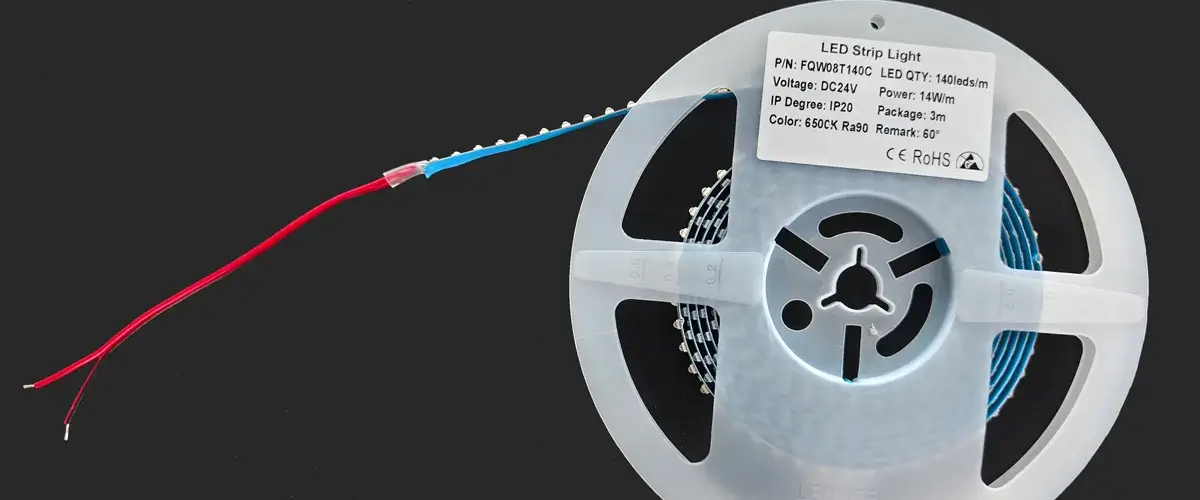
Per comprendere con precisione il consumo energetico delle luci a LED, è essenziale cogliere prima diversi concetti e unità fondamentali, che sono fondamentali nella selezione del prodotto, nella distribuzione dell'alimentazione del sistema e persino nelle offerte e nei prezzi. Vuoi saperne di più? Leggi il nostro blog: Guida completa alle strisce luminose a LED.
1. Potenza (Watt, W) - l'indicatore di base per il consumo di energia
La potenza delle strisce luminose a LED è tipicamente misurata in "Wats per metro (W/m)", indicando il consumo energetico per metro della striscia luminosa alla tensione nominale.
Ad esempio, una striscia luminosa con una potenza nominale di 14,4 W/m e una lunghezza di 5 metri ha una potenza operativa di:
14,4 × 5 = 72 W
Ciò significa che la striscia luminosa consuma 72 watt di potenza all'ora durante il funzionamento.
2. Tensione (V) - Determina la configurazione di corrente e cablaggio
Le tensioni di funzionamento comuni per le strisce luminose a LED includono 12V, 24V e 48V. Sebbene la tensione non influisca sul consumo totale, determina l'entità della corrente e le perdite di linea:
- Allo stesso livello di potenza, una tensione più elevata si traduce in una corrente di tensione inferiore e una minore caduta di tensione, rendendolo più adatto per il cablaggio a lunga distanza.
Ad esempio:
72W @ 12V → Corrente = 6A
72W @ 24V → Corrente = 3A
Ciò è particolarmente importante per le applicazioni di illuminazione commerciale che utilizzano strisce luminose più lunghe di 10 metri. Dovrei scegliere le luci di striscia a LED da 12 o 24v? Leggi il blog: Strisce luminose a LED a 12 V e a 24 V: Come scegliere?
3. Elettricità COn Subtion (kWh, kilowattora)—A kocchi strisciosi IOadicatore Ainflitto Elentittezza COST
Per stimare i costi effettivi dell'elettricità, l'energia deve essere convertita in "chilowattora (kWh)", comunemente denominata "kWh". La formula di calcolo è la seguente:
Consumo di energia elettrica (kWh) = potenza (W) × Tempo di utilizzo (ore) ÷ 1000
Esempio: una striscia luminosa a LED con una potenza totale di 72W, utilizzata per 8 ore al giorno, operante per 30 giorni al mese:
Consumo giornaliero di energia elettrica: 72 × 8 ÷ 1000 = 0,576 kWh
Consumo mensile di energia elettrica: 0,576 × 30 = 17,28 kWh
Se la tariffa dell'elettricità è $0,12 per kWh, la bolletta mensile dell'elettricità sarebbe di circa 17,28 × 0,12 = $2,07.
4. Luminoso EFFICACY (LM/W)—An IOimportante IOndicatore per Estima Eirritazione Eefficienza
L'efficacia luminosa si riferisce al numero di lumen (flusso di luce) in uscita per watt di potenza, misurata in lm/w. Per applicazioni commerciali, si consiglia di selezionare strisce luminose a LED con un'efficacia luminosa di ≥ 100 lm/W, che può garantire la luminosità riducendo il consumo di energia.
Comprendendo questi concetti di base, puoi pianificare il consumo di elettricità in modo più scientifico e selezionare soluzioni di strisce luminose a LED veramente efficienti dal punto di vista energetico ed economiche. Successivamente, approfondiremo i fattori chiave che influenzano il consumo di energia nelle applicazioni pratiche.
Guarda il video per sapere come calcolare il consumo energetico delle luci a LED.

Fattori chiave che influenzano il consumo energetico della luce a strisce LED
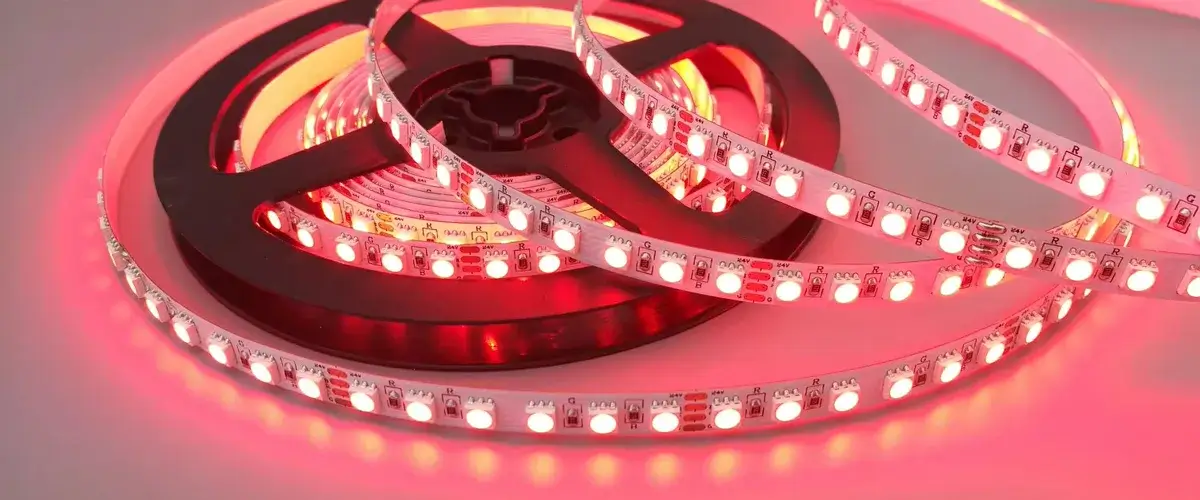
Mentre la potenza nominale delle luci a LED è una metrica importante, il consumo energetico effettivo nelle applicazioni del mondo reale è spesso influenzato da una combinazione di molteplici fattori. Comprendere queste variabili può aiutare a valutare accuratamente i costi operativi del progetto e la progettazione elettrica.
1. Densità LED (LED per metro)
Più LED per metro, maggiore è il consumo energetico per metro e più luminosa è la luce.
| Densità LED | Gamma di potenza comune | Scenari applicativi |
| 30 LED/m | 4,8–7,2 W/m | Illuminazione interna del mobile, illuminazione soffusa |
| 60 LED/m | 9,6–14,4 W/m | Scatole di luce pubblicitarie, retroilluminazione per finestre |
| 120 LED/m | 18–24 W/m | Illuminazione principale ad alta luminosità, illuminazione del display |
2. Temperatura del colore e tipi di colore
- Le strisce luminose monocromatiche (ad es. 3000K bianco caldo o 6000K bianco freddo) generalmente hanno un consumo energetico inferiore. (Vuoi saperne di più sulle differenze tra queste temperature di colore? Leggi il nostro post sul blog: 3000K vs 4000k vs 5000k vs 6000k: qual è la differenza?)
- Le strisce luminose RGB o RGBW in genere contengono più chip, con conseguente potenza significativamente maggiore per unità di lunghezza; le strisce luminose RGBW possono anche superare i 20 W/m.
Inoltre, l'efficienza luminosa (Lm/W) dei LED con diversi colori di luce varia; ad esempio, la luce bianca fredda ha tipicamente una maggiore efficienza luminosa rispetto alla luce rossa o blu.
3. Tensione nominali: 12 V vs 24 V vs 48 V
- Sebbene la tensione stessa non determina il consumo di energia, influisce direttamente sulla dimensione della corrente e sulle perdite di linea.
- Per cablaggi superiori a 5 metri o applicazioni commerciali, i sistemi a 24 V o 48 V offrono vantaggi, riducendo efficacemente la caduta di tensione e migliorando l'efficienza energetica.
4. Controllo e modalità operative di dimming
in cui Controller di oscuramento (come l'attenuazione PWM, il dimming 0-10V o il controllo DMX) non sempre le strisce LED funzionano alla luminosità di 100%, con conseguente riduzione del consumo medio.
Ad esempio, la riduzione della luminosità a 70% utilizzando il controllo PWM si traduce in una corrispondente riduzione di 30% nel consumo energetico effettivo.
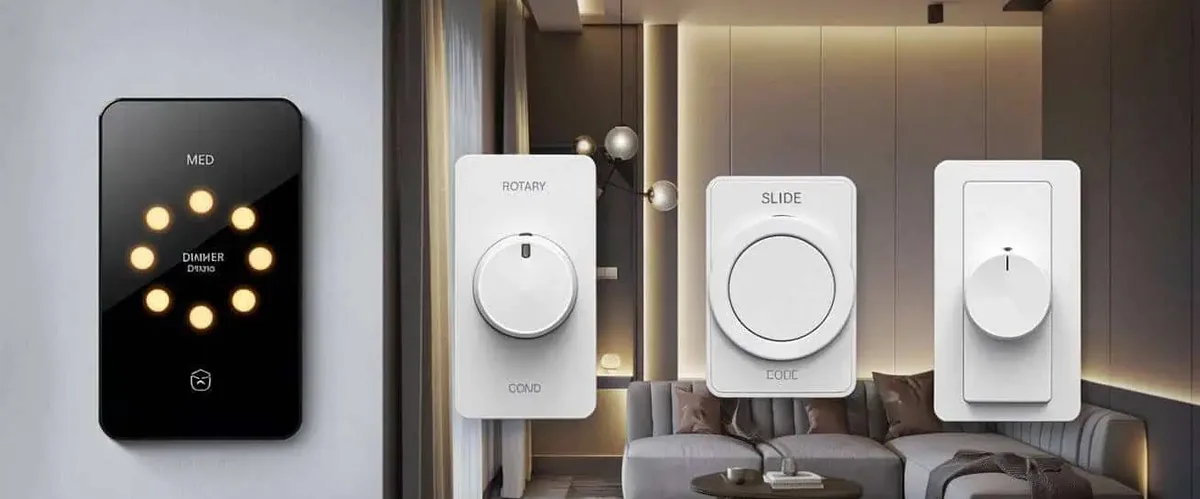
5. condizioni di ambiente operativo e dissipazione del calore
Gli ambienti ad alta temperatura o la scarsa dissipazione del calore possono ridurre l'efficienza luminosa e l'efficienza elettrica dei chip LED, portando potenzialmente a un consumo di energia anomalo.
- Se installato in canali di alluminio chiusi, interni di armadi o ambienti sigillati all'aperto, si consiglia di utilizzare Profili in alluminio a LED per l'ottimizzazione della dissipazione del calore.
- Per ogni aumento di 10°C della temperatura ambiente, le prestazioni dei LED possono diminuire di oltre 5%.
6. Durata e frequenza di utilizzo
- Le strisce a LED commerciali che operano per oltre 10 ore al giorno si tradurranno in costi mensili significativamente più elevati rispetto agli scenari di utilizzo residenziale a breve termine.
- Per scenari operativi 24 ore su 24, 7 giorni su 7 (come minimarket o segnaletica a catena), la selezione di modelli ad alta efficienza e bassa energia può ridurre significativamente i costi dell'elettricità a lungo termine.
In sintesi, il consumo energetico della luce a strisce LED non è semplicemente un parametro nominale "w/m", ma una variabile di sistema dinamica. La valutazione ragionevole di questi fattori può aiutarti a controllare i rischi di consumo energetico e le pressioni sul budget dall'inizio del progetto.
Confronto di consumo energetico di diversi tipi di luci a strisce LED
Nei progetti reali, la selezione delle luci a LED spesso comporta il bilanciamento della luminosità, del consumo energetico e delle prestazioni. Le luci a LED con specifiche di imballaggio diverse, metodi di illuminazione e applicazioni funzionali presentano differenze significative nel consumo energetico per unità. Quello che segue è un tipico confronto del consumo energetico di diversi tipi di luci a strisce a LED.
Parametri di consumo di energia della striscia LED comuni in breve
| Tipo di striscia chiara | Tensione | Densità dei LED | Potenza | Efficienza luminosa (Lm/W) | Scenari di applicazione |
| 3528 Striscia luminosa mono | DC12V/24V | 60 LED/m | 4,8W/m | 80–100 | Illuminazione ambientale, retroilluminazione domestica |
| Striscia di luce RGB 5050 | DC12V/24V | 60 LED/m | 14,4W/m | 60–75 | Decorazione dinamica, controllo multicolore |
| 2835 Striscia LED ad alta luminosità | DC24V | 120 LED/m | 19,2W/m | 100–120 | Illuminazione commerciale, fonte di luce principale al dettaglio |
| Striscia LED COB | DC24V | 480 LED/m | 11W/m | 100–110 | Nessuna applicazione in zona oscura, retroilluminazione della finestra |
| Striscia LED RGBW 4 in 1 | DC24V | 60 LED/m | 18–20 W/m | 50–65 | Illuminazione per esterni, illuminazione di scena multicolore |
Raccomandazioni di selezione (in base ai requisiti del progetto):
- Focus sull'efficienza energetica → Scegli luci a LED con un'efficacia luminosa superiore a 100 lm/W, o monocromatica o Strisce LED COB.
- Richiede effetti dinamici multicolori → Considera le luci a strisce LED RGB o RGBW digitali indirizzabili, ma nota l'aumento del consumo energetico totale.
- La ricerca di un'efficienza luminosa uniforme e l'illuminazione a puntino → Le strisce luminose a LED COB sono la scelta ideale.
- Per l'illuminazione lineare a lunga distanza → Dai priorità alle strisce luminose a LED a lungo termine a 24 V o 48 V per ridurre la caduta di tensione.
Attraverso questi confronti, puoi selezionare in modo più intuitivo strisce luminose a LED che bilanciano prestazioni e consumo energetico, evitando problemi come sovraspecifiche, decadimento rapido della luce o costi elevati dell'elettricità. Per ulteriori informazioni su come scegliere e acquistare luci a strisce a LED, leggi il blog: Guida completa all'acquisto di strisce luminose a LED.
Raccomandazioni di ottimizzazione del risparmio energetico per applicazioni commerciali
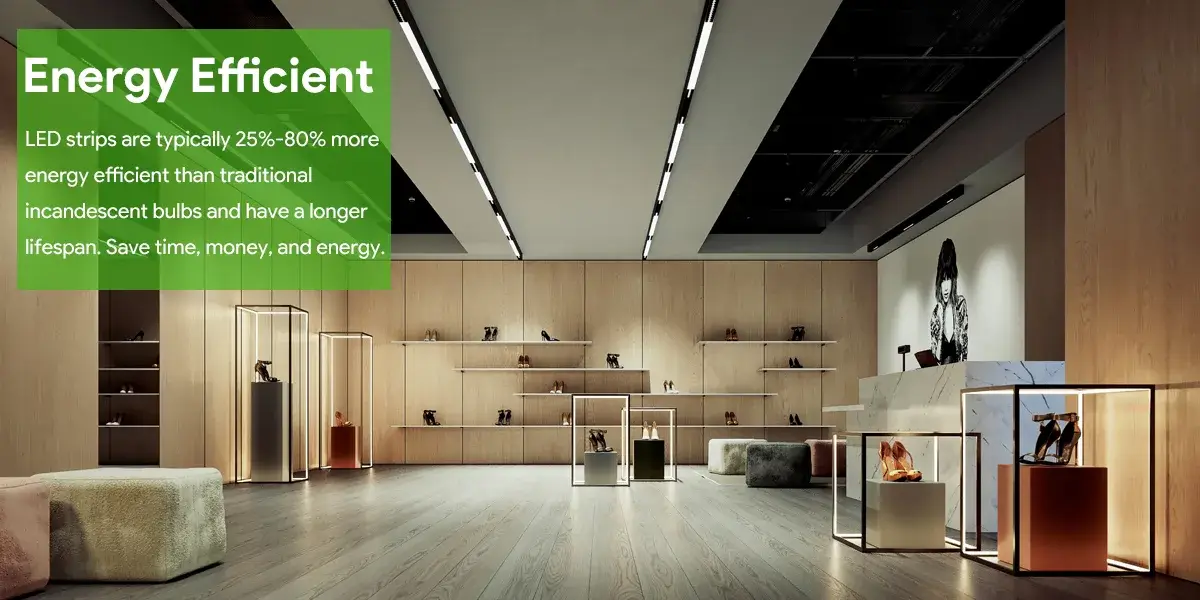
Nelle applicazioni di illuminazione commerciale e industriale, le strisce luminose a LED spesso funzionano per lunghi periodi di tempo, coinvolgono cablaggi complessi e vengono utilizzati in diversi ambienti. Anche piccoli errori di configurazione possono causare scarti energetici o una riduzione della durata. Di seguito sono riportate alcune strategie comprovate di risparmio energetico che possono aiutarti a raggiungere una maggiore efficienza energetica e ridurre i costi operativi e di manutenzione nei tuoi progetti.
1. Dare priorità ai prodotti ad alta efficienza e di alta qualità (≥100 lm/W).
Una maggiore efficacia luminosa significa un consumo energetico inferiore per la stessa luminosità. Ad esempio, una striscia di luce da 100 lm/W richiede solo 10 W per raggiungere 1000 lumen, mentre una striscia luminosa da 80 lm/W potrebbe richiedere 12,5 W, con conseguente differenza significativa rispetto al funzionamento esteso.
Suggerimento: dare priorità all'uso di 2835 Striscia LED ad alta luminosità o striscia LED COB, che offrono un'efficacia luminosa superiore e una migliore dissipazione del calore.
2. Pianificare ragionevolmente la lunghezza della striscia del LED per evitare eccessiva speculazione o spreco.
- Calcola la potenza in base alla lunghezza effettiva per evitare "sovra-riserva", portando a un consumo eccessivo di energia.
- Per strutture lineari o progetti di illuminazione di contorno, si consiglia di misurare con precisione la lunghezza richiesta in base ai disegni CAD.
Suggerimento: Le strisce LED in eccesso possono essere incorporate nei sistemi di controllo a zone o tagliati su misura per ridurre il consumo di energia non necessario.
3. Ottimizzare l'alimentazione e la struttura del cablaggio per ridurre al minimo le perdite di tensione.
- selezionare Alimentatori ad alta tensione ad alta efficienza (efficienza di conversione ≥ 90%) compatibile con le strisce LED.
- Utilizzare fili di rame sufficientemente spessi per prevenire Cadute di tensione e aumento del consumo di energia causato dalla trasmissione a lunga distanza.
- Per progetti con distanze di cablaggio superiori a 10 metri, si consiglia di utilizzare un sistema DC24V o DC48V.
Esempio: In una configurazione di cablaggio di 15 metri, un sistema DC12V potrebbe riscontrare una luminosità irregolare a causa della caduta di tensione, mentre un sistema DC24V può risolvere efficacemente questo problema.
4. Implementare sistemi di controllo di regolazione/intelligente.
L'attenuazione non solo migliora l'atmosfera e l'esperienza visiva, ma riduce anche direttamente il consumo energetico. I metodi di controllo tipici includono
- Dimming PWM (adatto per sistemi di illuminazione per ambienti interni/a binario)
- Dimming 0–10V (adatto per l'illuminazione per uffici commerciali)
- Controllo DMX (adatto per progetti dinamici RGB)
- Controllo timer + sensore (adatto per spazi pubblici, sale espositive, ecc.)
Riferimento dati dimmer: Se attenuato alla luminosità 70%, il consumo effettivo di energia può essere ridotto di circa 30%.
5. Combinare con profili di alluminio o substrati conduttivi di calore per migliorare l'efficienza di dissipazione del calore.
L'efficace dissipazione del calore non solo prolunga la durata della striscia LED, ma migliora anche l'efficienza del circuito e riduce la perdita di potenza. Combinazioni consigliate:
- Profili in alluminio a forma di U + Coperture per diffusori
- Per le installazioni all'aperto, utilizzare canali in alluminio impermeabili e garantire un design del flusso d'aria adeguato.
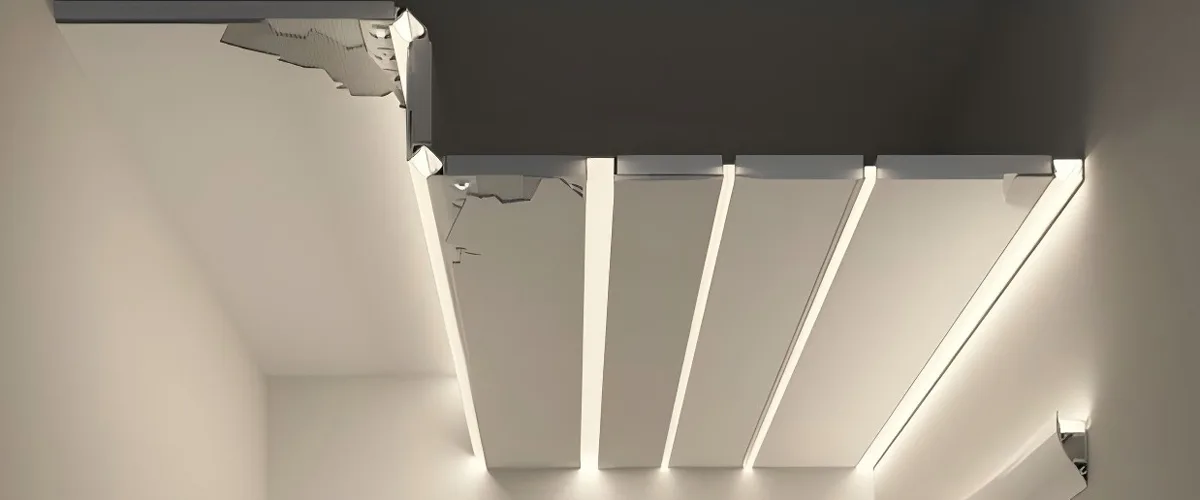
6. Eseguire una manutenzione regolare.
Polvere e sporco possono accumularsi su strisce luminose a LED nel tempo, riducendone la luminosità e l'efficienza. La pulizia regolare assicura che mantengano prestazioni ottimali. Inoltre, ispeziona regolarmente le connessioni e le fonti di alimentazione per assicurarti che funzionino correttamente.
Implementando le strategie di cui sopra, non solo puoi ridurre i costi complessivi dell'elettricità, ma anche migliorare la stabilità e la durata dell'intero sistema di illuminazione a strisce luminose a LED, riducendo così al minimo la frequenza e l'allocazione del budget per la manutenzione futura.
Casi applicativi reali ed esempi di calcolo del consumo energetico
Per ottenere una comprensione più intuitiva delle prestazioni del consumo energetico delle strisce luminose a LED, utilizziamo tre scenari di illuminazione commerciali comuni come esempi per condurre stime dettagliate del consumo di elettricità e dei costi dell'elettricità e confrontarli con soluzioni di risparmio energetico.
Caso 1: illuminazione per vetrine del negozio di abbigliamento (usando strisce luminose mono pannocchia)
Specifiche della striscia di luce: Striscia luminosa 24V, 14W/m, efficacia luminosa 100 lm/W
Lunghezza di installazione: 10 metri
Tempo medio giornaliero di funzionamento: 10 ore
Ciclo operativo: 30 giorni al mese
Riferimento tariffa energia: $0.12/kWh
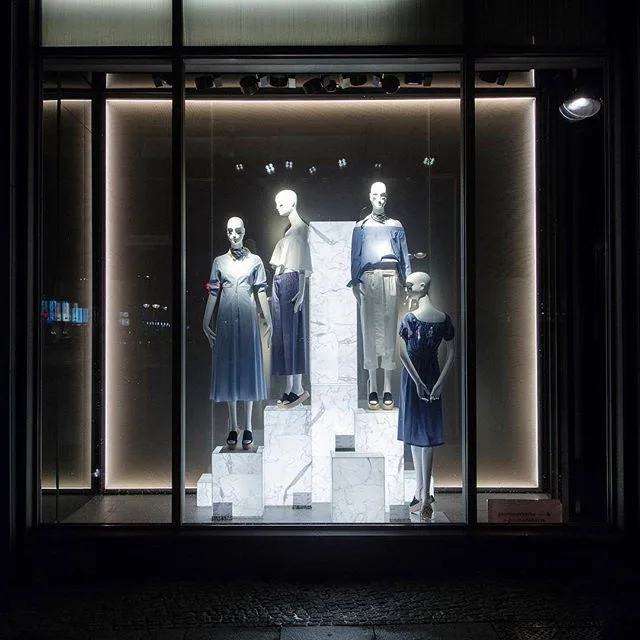
Calcolo del consumo di energia:
Potenza totale = 14W × 10 metri = 140W
Consumo giornaliero di energia elettrica = 140W × 10 ore ÷ 1000 = 1,4 kWh
Consumo mensile di elettricità = 1,4 × 30 = 42 kWh
Costo mensile dell'elettricità = 42 × $0.12 = $5.04
Costo annuale dell'elettricità = $5.04 × 12 = $60.48
Ottimizzazione risparmio energetico:
Se un Striscia LED 2835 ad alta luminosità Con una maggiore efficacia luminosa (ad es. 190 lm/W), il consumo energetico è di soli 12 W/m, riducendo la bolletta mensile dell'elettricità a $4.32 e risparmiando oltre $8.64 per dispositivo all'anno.
Caso 2: Illuminazione del contorno del corridoio del centro commerciale (utilizzando strisce LED RGB)
Specifiche della striscia LED: Striscia LED RGB 24V, 14.4W/m
Lunghezza di installazione: 30 metri
Tempo medio di utilizzo giornaliero: 12 ore (controllo automatico a tempo)
Ciclo operativo: tutto l'anno
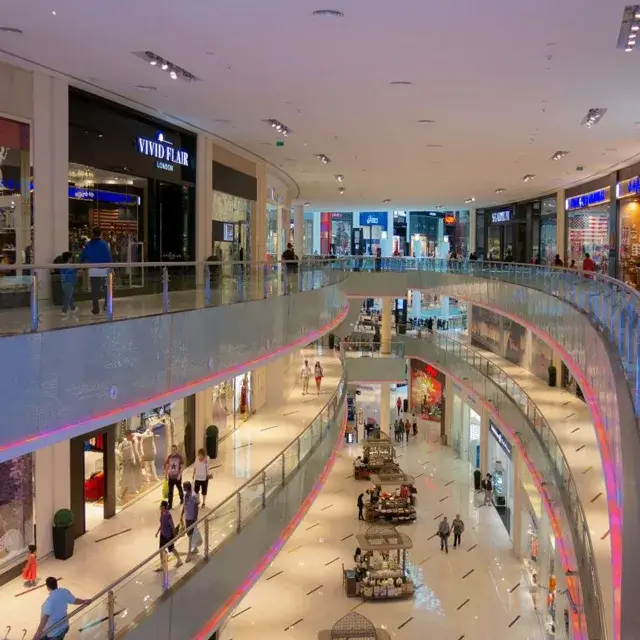
Calcolo del consumo di energia:
Potenza totale = 14,4 W × 30 metri = 432 W
Consumo giornaliero di energia elettrica = 432 × 12 ÷ 1000 = 5,18 kWh
Consumo annuo di energia elettrica = 5,18 × 365 ≈ 1.891,7 kWh
Costo annuale dell'elettricità ≈ $227,00
Ottimizzazione risparmio energetico:
Introducendo il controllo di dimmerazione DMX, con una luminosità media di 70% in base al funzionamento effettivo, il consumo energetico totale viene ridotto a 302W e il costo annuale dell'elettricità diminuisce a circa $158.70, risparmiando $68+/anno/posizione.
Caso 3: illuminazione a soffitto per ufficio (striscia di luce lineare incorporata)
Specifiche della striscia di luce: 24V 2835 striscia luminosa ad alta luminosità, 18W/m, CRI > 90
Lunghezza totale di installazione: 50 metri
Tempo di utilizzo: 8 ore al giorno, operante nei giorni feriali (22 giorni al mese)
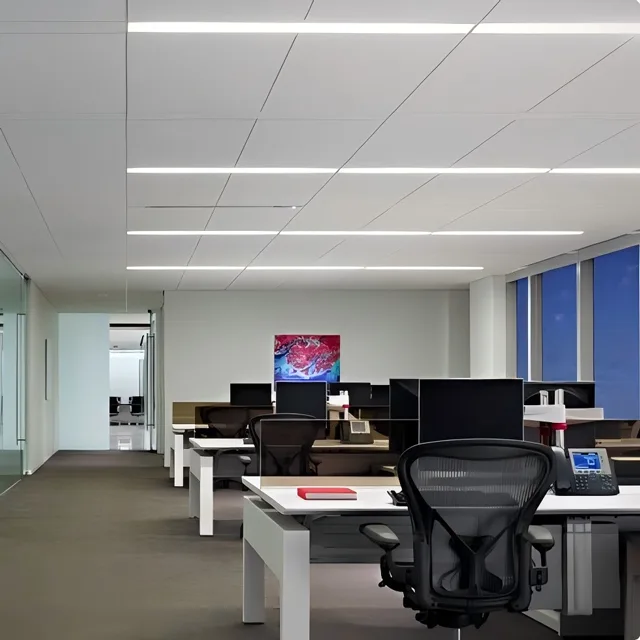
Calcolo del consumo di energia:
Potenza totale = 18 × 50 = 900W
Consumo mensile di energia elettrica = 900 × 8 × 22 ÷ 1000 = 158,4 kWh
Costo mensile dell'elettricità = 158,4 × $0,12 = $19.01
Costo annuale dell'elettricità = $19.01 × 12 = $228.12
Ottimizzazione risparmio energetico:
- Ottimizza una striscia di luce COB da 130 lm/W ad alta efficienza, che richiede solo 8 W per metro → risparmi annuali sui costi dell'elettricità di circa $120+.
- Installare un sistema di dimmerazione 0-10V per regolare la luminosità in base alla luce naturale, offrendo un maggiore potenziale di risparmio energetico.
Sintesi:
| scena | Costo annuale dell'elettricità annuo originale | Costo annuale dell'elettricità dopo l'ottimizzazione del risparmio energetico | Risparmio annuale sui costi dell'elettricità |
| illuminazione per finestre | $60.48 | $51.84 | $8.64 |
| Illuminazione del contorno | $227.00 | $158.70 | $68.30 |
| Illuminazione principale dell'ufficio | $228.12 | $101.37 (stimata) | $126.75 |
Per progetti di media e grande scala, anche un risparmio energetico di 2W per metro può comportare significative ottimizzazioni dei costi operativi una volta accumulati.
FAQ
Rispetto all'illuminazione tradizionale, le strisce luminose a LED hanno già un consumo energetico molto basso. Assumendo come esempio una striscia luminosa a LED da 12 W/m con una lunghezza di 10 metri, anche se lasciata in posa per 24 ore al giorno, il consumo giornaliero di energia elettrica è di soli 2,88 kWh. Con una tariffa di elettricità di $0.12/kWh, il costo giornaliero dell'elettricità è di circa $0.35. Tuttavia, se un gran numero di strisce viene distribuito e mantenuto per lunghi periodi, si consiglia comunque di incorporare controlli di fasatura o discrezione per ridurre ulteriormente il consumo di energia.
In teoria, con la stessa potenza nominale (ad esempio, 14,4 W/m), il consumo energetico di strisce LED da 12 V e 24 V è lo stesso. Tuttavia, poiché il sistema a 12V ha una corrente più elevata, è più soggetto a caduta di tensione e perdita di calore durante il cablaggio a lunga distanza, riducendo così l'efficienza e aumentando il consumo di energia. Per applicazioni superiori a 5 metri o uso commerciale, si consiglia di utilizzare un sistema a 24V o 48V.
si. Ogni modulo LED in una striscia LED RGB contiene in genere tre chip di colore (rosso, verde e blu), con un consumo energetico più elevato. Le strisce LED RGBW includono anche un chip a luce bianca aggiuntiva, con un consumo energetico che raggiunge potenzialmente 18–20 W/m. Le strisce LED monocromatiche in genere hanno una potenza compresa tra 4,8 e 12 W/m. Se l'efficienza energetica è una priorità, le aree di utilizzo RGB dovrebbero essere pianificate ragionevolmente.
si. Si consiglia di utilizzare un misuratore di potenza montato su presa o un misuratore di potenza alla fonte di alimentazione con letture kilowattora (kWh) per misurare direttamente l'alimentazione in tempo reale, il consumo cumulativo di elettricità e i costi di elettricità stimati dell'intero sistema. Questo è altamente adatto per test in loco e valutazioni dell'efficienza energetica.
Sì, specialmente con metodi di dimming come PWM, 0-10V, DALI e DMX. Quando la luminosità si riduce, la corrente diminuisce in modo sincrono e anche il consumo energetico diminuisce. Ad esempio, l'impostazione della luminosità della striscia luminosa su 70% riduce il consumo di energia di circa 30%, prolunga anche la durata degli apparecchi di illuminazione e riduce la frequenza di manutenzione.
Conclusione: perché scegliere le luci a LED ad alta efficienza di SIGNLITELED?
Nel mercato dell'illuminazione di oggi, che dà la priorità all'efficienza energetica e alla protezione ambientale, il risparmio energetico non è solo una tendenza, ma anche una garanzia cruciale per il controllo del budget del progetto e i rendimenti a lungo termine. Attraverso questo articolo, abbiamo analizzato in modo completo i fattori che influenzano il consumo di luce a strisce a LED e le strategie di ottimizzazione del risparmio energetico, dai calcoli di base ai casi di studio del mondo reale.
SignLiteled si impegna a fornire ai clienti:
- Soluzioni a LED ad alta efficienza (100-200 lm/w) per ridurre il consumo di energia per metro
- Servizi precisi di corrispondenza e progettazione di alimentatori per prevenire sovraccarichi e sprechi
- Compatibilità Smart Control per un facile dimming e risparmio energetico a zone
- Supporto alla personalizzazione specifica del progetto per soddisfare l'equilibrio tra efficacia luminosa e consumo energetico in vari scenari
Se stai cercando Luci a striscia LED Che bilanciano luminosità, durata ed efficienza energetica, contattaci per richiedere campioni di prova o supporto tecnico individuale.

